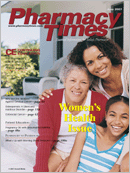Publication
Article
Pharmacy Times
Teenage Rx Drug Abuse Rising
Author(s):
A recent report from the Office of National Drug Control Policy (ONDCP) indicates that females are more apt to abuse prescription drugs than their male counterparts.This is opposite the abuse of common illicit drugs such as marijuana, cocaine, and heroin.
The report indicated that this finding is especially apparent in teenagers. Almost 1 in 10 teenage girls have abused prescription drugs, compared with 1 in 13 teenage boys. The possible reason is the pressure that girls experience as teens regarding their appearance and their overall confidence.
The common misconception is that prescription drugs cannot be as harmful as illicit drugs, and that overdosing on these substances is not nearly as dangerous as a cocaine or heroin binge. “Talk to young women, our daughters, the young women in our homes, and make sure the understanding that they’ve been given falsely that these are safe, that these are different, is corrected,” said Director of the White House ONDCP John Walters.
This is good advice for all of us adults—to ensure that we talk to our teenagers, both male and female, and make them aware of these dangers. Law enforcement officers and pharmacists deal with this problem daily, advising people on the risks of certain medications, but do we then go home and talk to our teenagers about the potential danger of prescription drug abuse? A pharmacist, in particular, could have a huge impact on anyone involved in or considering abusing pharmaceuticals—do not forget to use that power when you can.
In my days at the Cincinnati Police Department, we saw females outnumbering male abusers in prescription drug abuse by 60% versus 40%. At that time, teenage abuse of pharmaceuticals was very low, as the Internet was new, and teens’ knowledge of these drugs in their own medicine cabinet was just surfacing.
Recently, Arizona teenagers were caught selling carisoprodol at their school. It was apparent that teenagers were crossing the border into Mexico and buying the drug, sometimes 1000 pills at a time. Classmates were caught snorting carisoprodol at their desks, and the operation was dismantled. Cariso-prodol can certainly be abused by itself, but it makes an excellent companion when abusing hydrocodone or coming down off of cocaine highs.
If you have ever been in those border towns, buying prescription drugs is very easy, as you are approached on the street by pill vendors who are sometimes as young as 10 years old. During my last trip to Nuevo Laredo, Mexico, which is a dangerous place to visit with the current drug violence, street people vied for my business, having me review a list of available pharmaceuticals, which included virtually everything that could be successfully abused. Getting caught at the border is unlikely with the volume of people who cross on foot and by motor vehicle every day.
Many organizations are trying to get to the bottom of the rise in teenage prescription drug abuse. Family and friends are listed as the most common sources by teens being surveyed, but where do those people get their drugs? Is it the Internet, family medicine cabinets, home care and hospice patients, international smuggling, or adults who doctor shop and sell their pills? All of these options represent possible sources, and 1 or 2 may be responsible to a lesser degree. Females appear to be more likely to abuse pharmaceuticals, probably in part due to the misconception that they are safer than street drugs.
I agree with Walters—education is key when it comes to prescription drug abuse, not only to our teenagers, but also to adults who may be able to influence teenagers and likely do not know the potential problems with pharmaceutical diversion. Prescription drug abuse is a different problem than most substance abuse issues, because we take prescription drugs and encourage our children to take their medicine. Now that they have grown up into their pre-adult life, we have to let them know that prescription drugs can have a downside when one consumes medication that was not prescribed to one by a physician in a face-to-face visit and dispensed by a pharmacist.
John Burke, commander of the Warren County, Ohio, drug task force and retired commander of the Cincin-nati Police Pharmaceutical Diversion Squad, is a 38-year veteran of law enforcement. Cmdr Burke also is the current president of the National Association of Drug Diversion Investigators.







